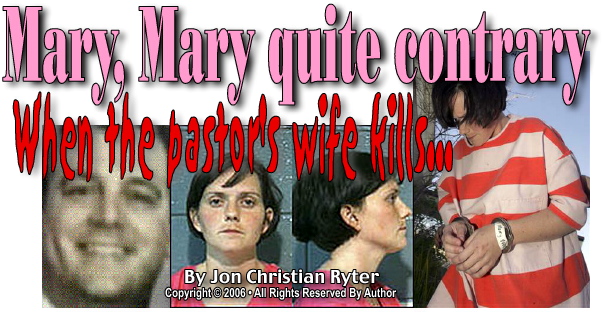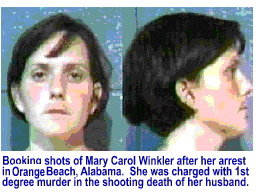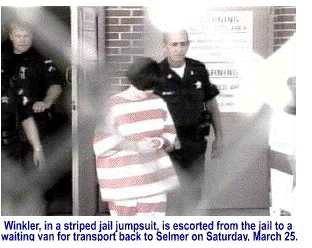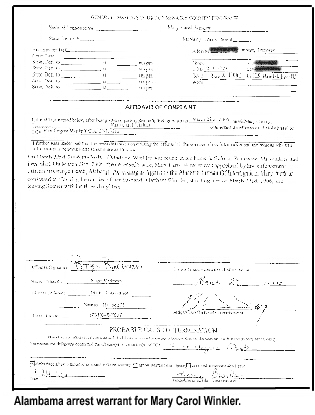
News
Behind the Headlines
Two-Cents Worth
Video of the Week
News Blurbs
Articles
Testimony
Bible Questions
Internet Articles (2015)
Internet Articles (2014)
Internet
Articles (2013)
Internet Articles (2012)
Internet Articles (2011)
Internet Articles (2010)
Internet Articles
(2009)
Internet Articles (2008)
Internet Articles (2007)
Internet Articles (2006)
Internet Articles (2005)
Internet Articles (2004)
Internet Articles (2003)
Internet Articles (2002)
Internet Articles (2001)


 hen
the nation learned that thirty-two year old Mary Carol Winkler
and her children were not victims of a depraved killer who visited
their McNairy County, Tennessee home and brutally killed her husband,
Matthew Brian "Wink" Winkler, they were immediately
relieved—only to recoil in stunned disbelief when, a short
time later, they learned at Mary Winkler had confessed
to shooting her husband one time in the back with a shotgun, killing
him. Winkler waived extradition and was returned to Selmer,
Tennessee on Saturday, March 25.
hen
the nation learned that thirty-two year old Mary Carol Winkler
and her children were not victims of a depraved killer who visited
their McNairy County, Tennessee home and brutally killed her husband,
Matthew Brian "Wink" Winkler, they were immediately
relieved—only to recoil in stunned disbelief when, a short
time later, they learned at Mary Winkler had confessed
to shooting her husband one time in the back with a shotgun, killing
him. Winkler waived extradition and was returned to Selmer,
Tennessee on Saturday, March 25.
Selmer
police officials drove to Orange Beach, Alabama to take custody
of the confessed killer. On Thursday, March 23 the wife of slain
Selmer Fourth Street Church of Christ minister Matthew Winkler,
31, provided police with the details of how—and why—she
shot him in the early afternoon of March 22, 2006, before school
let out. At least one of the children, Breanna, was home.
 She
appeared to be unaware that her father had been killed. Winkler
told police authorities from Alabama and Tennessee that, after
shooting him, she loaded her three young daughters (Patrica,
8; Mary Alice, 6; and Breanna, 1) into the family's
minivan and headed for Orange Beach, Alabama—350 miles from
Selmer.
She
appeared to be unaware that her father had been killed. Winkler
told police authorities from Alabama and Tennessee that, after
shooting him, she loaded her three young daughters (Patrica,
8; Mary Alice, 6; and Breanna, 1) into the family's
minivan and headed for Orange Beach, Alabama—350 miles from
Selmer.
Selmer
police charged Winkler with first degree murder because
of three facts. First, she fatally shot her husband in the back,
negating any chance she might later have had to claim self-defense
since, when your adversary is walking away, any prior threat to
your safety has been minimized and. legally, lethal force would
no longer be construed as a valid self-defense option in a family
dispute unless, of course, the spouses had turned away to pick
up a weapon.  Second,
Winkler rented the beach condo for herself and her daughters
prior to the shooting, indicating to police that she pre-planned
not only the murder of her husband but an escape route for herself
and her children. And, finally, prior to the crime Winkler
got—and apparently loaded—the shotgun that was used
in the crime. (Since normal families don't keep loaded shotguns
in a home with three small children, there is an assumption that
Mary Winkler, with much forethought of action, got the
shotgun from a closet or gun cabinet and loaded it. If those suppositions
are true, then all of the elements needed to support a charge
of premeditated murder existed.)
Second,
Winkler rented the beach condo for herself and her daughters
prior to the shooting, indicating to police that she pre-planned
not only the murder of her husband but an escape route for herself
and her children. And, finally, prior to the crime Winkler
got—and apparently loaded—the shotgun that was used
in the crime. (Since normal families don't keep loaded shotguns
in a home with three small children, there is an assumption that
Mary Winkler, with much forethought of action, got the
shotgun from a closet or gun cabinet and loaded it. If those suppositions
are true, then all of the elements needed to support a charge
of premeditated murder existed.)
In her
taped confession, Mary Winkler told authorities why she
did it. At the time of her arrest, they weren't talking, fearing
that by allowing any information to leak out they might jeopardize
the prosecution of the case.  They
did, however, rule out infidelity and physical abuse. While dozens
of Internet blogs and even more websites speculated that Matthew
Winkler may have been a secret wife beater or a child-abuser,
there was no evidence to support the speculative claims.
They
did, however, rule out infidelity and physical abuse. While dozens
of Internet blogs and even more websites speculated that Matthew
Winkler may have been a secret wife beater or a child-abuser,
there was no evidence to support the speculative claims.
Several left of center child advocacy groups created their own unofficial investigations to determine if Mary Winkler may have killed her husband to protect her children. While abuse advocacy groups are quick to point out that most abused women keep their abuse secret out of shame until the bruises show up in places that can't be concealed, it is not likely anyone will turn up any evidence—or even concrete suspicion—that Matthew Winkler abused or mistreated either his wife or his three daughters because he didn't. If anything, Matthew Winkler was the verbally abused member of the family.
The simple reality is, on that fateful Wednesday, they argued about money. Money they did not have that Matthew Winkler invested in a "get-rich-quick" scheme that he believed was going to set the family on the path of financial independence. Only, it didn't happen. It appears, from the circumstances that were developing in the Winkler home, that Matthew Winklder made a bad investment and their nest egg was gone. In her anger, Mary Winkler picked up her husband's shotgun and shot him in the back. The serial abuser in the Winkler family was not Matthew. It was quiet Mary.
The people of Selmer, a quiet, peaceful rural community of 4,500 were puzzled when the murder happened. Townsfolk and members of the 200 person congregation of Winkler's church described Mary Winkler as "the perfect mother and the perfect wife." Matthew Winkler was a third generation minister. Before moving to Selmer in February, 2005, Winkler served as Youth Minister and taught Bible classes at a Church of Christ in McMinnville, Tennessee. According to Eva Ferrell, the principle of a Christian school in McMinnville where Matthew Winkler was employed as a teacher, the Winklers were the perfect family.
But, clearly, there was something wrong in Paradise. After she was charged, the media began questioning the Orange Beach police about motive. The police were quick to squash the notion that infidelity—by either Matthew or Mary Winkler—played a role in the murder. When reporters raised the specter of physical abuse, asking whether or not Mary Winkler had ever accused her husband of abuse, Tennessee Bureau of Investigation spokeswoman Jennifer Johnson said, "When something like this happens, you look at the history, the domestic violence, anything at all that gives you a clue as to what happened—or how it happened. We found nothing. No history of domestic violence."
 The
question was rephrased by a reporter who asked if there was any
evidence of verbal abuse. This time, the police sidestepped the
question. That suggested to the reporters that verbal, or emotional,
abuse may have been the reason given by Winkler.
The
question was rephrased by a reporter who asked if there was any
evidence of verbal abuse. This time, the police sidestepped the
question. That suggested to the reporters that verbal, or emotional,
abuse may have been the reason given by Winkler.
But, to the reporters playing the guessing game, it was equally as likely it postpartum depression intensified by the loss of her mother, Mary Nell, to cancer a year or so before the birth of Breanna may have triggered the tragedy. Mary Winkler's sister, Patrica, was born with spinal meningitis and died at age 8. Winkler's youngest daughter was hospitalized with health problems shortly after birth, adding a considerable amount of additional emotional trauma on what appears to be postpartum depression. It appeared the media was looking for an excuse that would somehow mitigate the crime. Had Matthew Winkler shot his wife in the back, would the media have turned over ever rock to find something to excuse his act?
The day before she shot Matthew—according to teachers at Selmer Elementary where Mary had just started her first day as a substitute teacher—she appeared visibly agitated and was constantly on her cell phone—so much so that at least one other teacher complained to the school principal. Apparently the news that the Winklers had lost their money came on Tuesday, festering in her mind for a day before it climaxed explosively on March 22, with Mary Winkler taking one life and destroyed four others..
A conscious decision to kill him was made on Tuesday. Among the calls she made was to reserve a condo in Orange Beach, Alabama—390 miles from Selmer. On Wednesday, Mar. 22, she carried out her plan while her two oldest daughters were in school. Making no attempt to conceal the body or clean up the crime scene, Winkler picked up her two oldest children from school and headed to Orange Beach without, it appears, second thoughts about the mess she left on the bedroom floor at the parsonage—or, about the people who would ultimately find the body—or the nightmares they would experience for quite some time because of it.
Yet, to those who knew her best, they said if you didn't know her personal history, you'd never know she had lost her mother or had a sick child. The church members who knew about her problems admitted that she showed no signs of stress. In fact, most of those interviewed by the press noted that "...[s]he was fun to talk to, and she laughed and had fun with life." Fourth Street Church of God member John Foote noted that "[w]hat struck everyone was how close they were [to one another] and the love they showed for each other. They seemed to be a loving, devoted family."
When Pastor Winkler did not show up at the Fourth Street Church of Christ Wednesday evening, church members drove to the parsonage to see if something was wrong. They found him, dead, on the bedroom floor. Within 24 hours the crime would be solved but, for the congregation, the mystery was just beginning.
When church member Pam Killingsworth visited Mary Winkler at the McNairy County Jail on March 26 she envisioned seeing a frightened shell of a woman. Killingsworth said what she saw was strange and somewhat unsettling. Winkler showed a complete lack of remorse. Killingsworth said Winkler wasn't distraught. What Killingsworth saw was the typically Winkler—serene, with her pasted on churchy smile and a pithy, peaceful look that belied her circumstances.
After the made-for-TV touching of hands through the bulletproof glass wall between them, Winkler thanked Killingsworth for visiting her. Killingsworth was more disturbed when she left the jail because she understood even less. If Mary Winkler was an emotionally abused wife, then the Winklers managed to keep their secret from everyone who knew them. "I can't believe this would happen," Killingsworth, who is the assistant principle at Selmer Elementary and knows Mary Winkler both as a substitute teacher at her school and the wife of her pastor. "The kids are just precious—and she was precious. He was one of the best ministers we've ever had—just super charismatic." .
When news reached Selmer that Mary Carol Winkler had confessed killing her husband, shocked residents greeted the confession with disbelief. "The Mary we knew," Church of Christ member Anita Whirley said as she planted yellow, red and purple pansies outside the church—the pastor's last planned project, that he did not live to complete, "didn't do this. She was a wonderful person. We just don't understand. They were a good Christian family. They always seemed so happy."
:"Everything we saw," said church member Janet Sparks, "belies what happened. It just doesn't go together. Something is amiss, and we don't know what it is." What went wrong in the Winkler marriage was something we can't see, can't gauge and, sometimes, can't imagine. Perhaps we should call it "occult abuse." You can't see it, but it must be there. Or, for the lack of a better name, let's just call it "marital trauma." Marital trauma can be called by a myriad of names. Verbal abuse. Emotional abuse. Psychological abuse. Or just plain domestic abuse. In its most common forms, abusive partners put down their spouse in a variety of belittling or demeaning ways: calling them names, cursing them, threatening them, throwing things at them, or a hundred different things designed to psychologically hurt or humiliate their mate.
The Psychology Department of the University of South Carolina interviewed 234 women to assess the relationship between physical abuse and emotional abuse. The study included women in long-term and short-term abusive relationships. Many of the women believed that emotional abuse was worse than physical abuse. In a broad sense, those experiencing emotional abuse believed that ultimately, it always evolves into physical abuse.
Every year an estimated 2 to 4 million women in the United States become the victims of domestic violence—but twice that amount, four to eight million spouses—men and women—become the victims of emotional violence, more commonly known as verbal or emotional abuse. Emotional abuse and physical abuse share a root cause—one person is determined to exercise power and control over another. More time than not, the abuser "wins" by making his or her subservient partner the center of his or her existence and conversely, the abuser becomes the entire universe of the abused. Typically, male abusers target the areas of his spouse's life that he knows are particularly sensitive. The emotional abuser will constantly attack those areas, mentally beating the spouse into absolute submission. Most of the time the abuser will successfully isolate his or her mate, cutting off their contact with the outside world
A 1999 study, published in "Violence and Victims", revealed that psychological abuse, coupled with the threat of physical abuse deals a double blow to the female victim who has been expecting the back of her mate's hand, his fist, or just a shove into a wall. Each time the verbal abuse begins, the victim's body recoils as it gears up for the expected physical blows that generally do not come. This will likely be the defense offered by Winkler. But claims of emotional abuse are much more difficult to substantiate than claims of physical abuse since the bruises left by emotional abuse are psychological, and generally, emotional abuse takes place in private.
But it appears, in the Winkler family, Matthew Winkler was the victim of verbal abuse, not Mary. The trial of Mary Winkler should be an interestng one. Her lawyers have their work cut out for them, so they will earn the money they get for the book they will write about the premeditated murder that happened in peaceful Selmer, Alabama on March 22, 2006.
Postscript on this article. Mary Winkler, with premediation over money problems the family was suffering, murdered her husband. The taking of human life is a sin committed against God. Claiming mental abuse, she found a sympathic jury and after serving a cakewalk prison sertence, she was released. It seemed to the public that even before she was incarcerated she was free. Now pretending to be the pious preacher's widow who deserved to be shot in the back with a 12-gauge shotgun, she is attempting to regain custody of her children. This woman she not be allowed within a State's-reach of her children for the rest of her natural life.

Copyright © 2009 Jon Christian Ryter.
All rights reserved.


